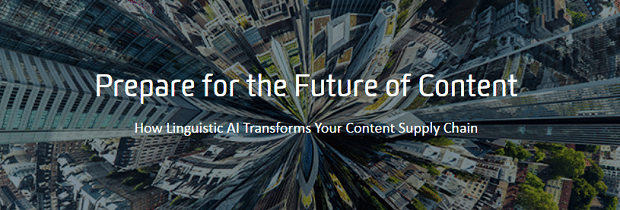
A new report from SDL on the Future State of Content examines the applications of linguistic AI – specifically, how AI can be used to help understand, transform and create language itself.
Companies are struggling to handle the growing volume and velocity of content required to engage with global audiences. And it’s expected to get worse: 93% say the content they produce will increase in the next two years*. SDL’s Enabling the Future of Content report addresses these challenges, offering insights on how companies can move towards an autonomous content supply chain of the future, capable of delivering any type of content to global audiences.
“Engaging with customers globally requires content, and lots of it. This content all needs to be tailored for different channels, devices – and of course languages,” explains Peggy Chen, CMO, SDL. “If brands want to stay ahead, they’re going to have to build autonomy into their supply chain, remove those mundane manual processes and make humans and machines work together to deliver more personalized experiences – at scale.”
Offering strategies and technical insights across the creation, translation and delivery stages of the content supply chain, the report suggests that the future content supply chain relies on Linguistic AI, a technology that helps to understand, transform and create content in any language.
The report has been developed based SDL’s experience of working with 90 of the globe’s top 100 brands and over 25 years’ leadership and innovation in content management and language solutions.
Create: Connect Content Repositories to Linguistic AI
Many organizations continue to approach content from a quantity perspective, spending an inordinate amount of time generating content. Because of the difficulty in crafting a message, visualizing it, and delivering it to the appropriate channels, this content is rarely individually tailored. Although companies strive to deliver relevant and personalized messages, for the most part, many can only hope the right content attracts the right person on the right channel at the right moment.
A content supply chain of the future will make content more usable regardless of where it created or stored. Similarly, multiple AIs – narrowly focused on specific business problems – will solve complex content problems, connecting an answer with an in-the-moment customer question. Linguistic AI will make content available immediately so that more time is spent extracting and producing value from content, rather than searching and managing it.
Translate: Machines Should Manage the Translation Process
Currently, humans decide what needs to be translated, who translates it, and how it is translated. This, alongside a multitude of other decisions, slows down the translation process considerably. The supply chain of the future will take a machine-first translation approach, streamlining many of these bottlenecks through Linguistic AI. It will analyze the impact of content and determine whether it merits human involvement, initiating handoffs between content management and translation management systems.
Linguistic AIs will pre-translate the content using neural machine translation (NMT), retrieve useful complementary texts, contact linguists and send them a translation kit. The human linguists who edit the pre-translation will then improve future machine translations since the AI learns from their edits.
Deliver: Content Is No Longer Created, It Should Be Synthesized
Content drives the digital experience – whether created by an organization’s employees or by customers. Content is also data, which breathes life into AI. In many cases, organizations sit on a mountain of valuable internal data that is hardly touched. While we may be producing more content than ever before, every person is limited in how much content they can actually consume. At a certain point, humans can only read, watch, and listen to so much. What matters is relevance.
An autonomous content supply chain of the future will synthesize content on demand, rather than just delivering more content. This synthesized content will be derived by combining internal content data and customer data. Linguistic AIs will make it easy to identify the intent of the human seeking information, connecting them with the appropriate content for more significant impact than ever before.
Click here to read SDL’s Enabling the Future of Content report
